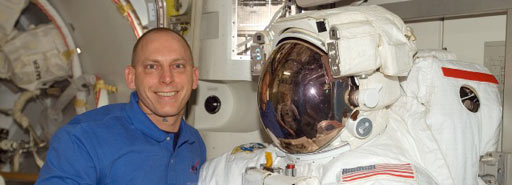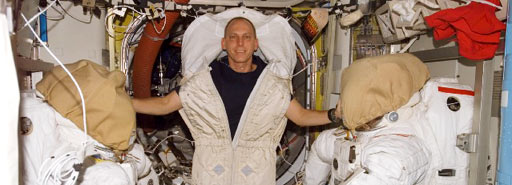Features
Clay Anderson: The Little Engine That Flew
08.01.07
He applied to the astronaut program 15 times before even getting an interview, and then waited two more years before being selected in 1998. Now, after 24 years of anticipation, he’s in space.
“1983 was the first time that I was technically eligible to submit an astronaut application, because I had a master’s degree and one year of experience,” Anderson said. “So I did. I simply submitted the application and then waited 15 years to get an interview.”

Image above: Expedition 15 Flight Engineer Clay Anderson poses for a photo with a U.S. spacesuit in the Quest Airlock. Credit: NASA
The process of becoming an astronaut has a lot of steps, and the first is applying. Out of the thousands of applications the astronaut office receives, only a few dozen applicants are chosen to come to Houston for a personal interview when a class is being selected. And that handful is then whittled down through interviews and medical physicals to the few who will actually be invited to join the next astronaut class. But even if you’re not chosen, you’re encouraged to continue updating your application each year.
And Anderson was more than willing to follow the advice – after all, it was something he’d wanted for decades.
“My mother says I wanted to be an astronaut when I was 4 or 5,” he said. “She says I told her I wanted to be an astronaut in the July 4th parade in my hometown, and she wrapped me up in tinfoil and I marched in the parade as a tinfoil Mercury astronaut. I got second place – she says I was robbed, I should have gotten first place.”
Anderson doesn’t much remember that, but he does remember waking up in the middle of the night five years later to watch the Apollo 8 astronauts go around the back side of the moon. And if he hadn’t already decided, that sealed the deal.
“That was pretty intriguing to me,” he said. “The fact that they lost communication when they went around the back side and couldn’t hear that beep tone everyone knows about, and when they came back to the front side and they hear that tone for the first time and they talked … That was pretty exciting for me. I thought that would be pretty cool to do.”
But he wasn’t sure how feasible actually doing it would be. In fact, it might not have happened at all if his college hadn’t happened to have an alumnus who worked for NASA.
“And it just so happened that the year I started my senior year, he came to pheasant hunt, and he pheasant hunted with the guidance counselor at Hastings College,” Anderson said. “They got to talking to one another – ‘What do you do?’ ‘I work for NASA.’ And the next thing you know, the counselor said, ‘Well, we have a young man who’s very interested in NASA here at Hastings. And the man said, ‘Well, we have a summer internship program.’”
The summer internship turned into two summer internships, and then into a permanent job after Anderson got his master’s degree. It was, in Anderson’s opinion, the second best thing to being an astronaut.

Image above: Tucked in a sleeping bag, Expedition 15 Flight Engineer Clay Anderson poses for a photo with two U.S. spacesuits. Credit: NASA
“I would work in Houston, at the Johnson Space Center, where all the astronauts worked, lived and trained, and be here where they were doing really cool things and getting ready to send a shuttle into space and eventually build a space station,” he said. “All that stuff seemed way cool to me. Even if I wasn’t selected as an astronaut, I was where the action was.”
But there were some hard things about it, too. Anderson worked in a group that occasionally gave presentations to astronauts. In fact, he gave a presentation to the 1978 astronaut class on shuttle rendezvous.
“Here I was in a room with a bunch of brand new astronauts who were doing exactly what I wanted to do,” he said. “And I had no idea how to get there.”
He decided that the answer was to do what he was doing well, try to move up the ladder a little and look for opportunities to make his resume stand out from the crowd – with little things like working as a college basketball referee and bigger things like taking a new job as Johnson Space Center’s emergency operations manager.
“Mentally it was hard to get that little card that said, ‘Thanks, we got your application, but we didn’t select you,’” Anderson said. “I wish I would have saved all those cards. But to do the updates was easy. I just kept a file, and each year I’d update what needed to be updated and send it off. And as I did that, every year, I’d look at my resume and think, ‘Well, what have I done spectacular or new that’s going to set me apart from the other guys?’”
And then, for some reason that he’s still not sure he can explain, in 1996, it worked and he got an interview.
“I almost quit applying before ’96,” Anderson said. “My wife and I had headed to Seattle to take a vacation and also to seek employment opportunities there. We came back and about a week later, I got a call from the astronaut office. That lit the flame again.”
Even then, it took one more try before Anderson was selected and another nine years before he actually flew. But now he is in the middle of a months-long stay on the International Space Station, and he said he just has one more thing to do before he’ll feel that he’s accomplished his goal.
“I think I’ll feel like a true astronaut when I come home having successfully completed all this,” he said. “The key thing I want to do is, I want to make the program proud of the work that we’ve done.”
Johnson Space Center, Houston